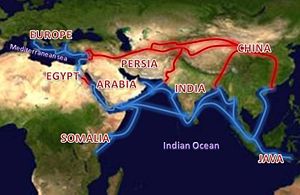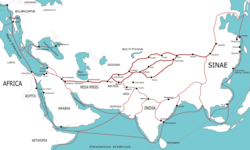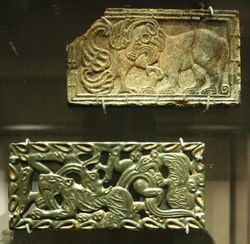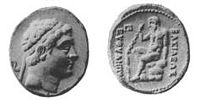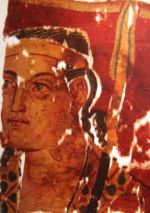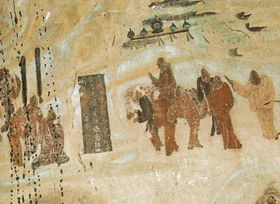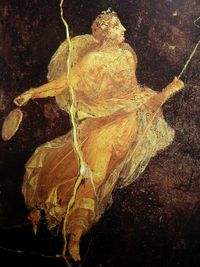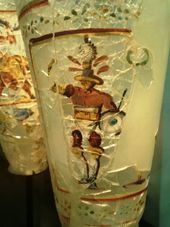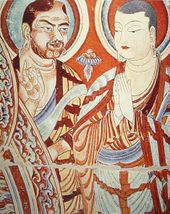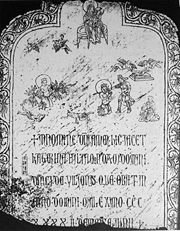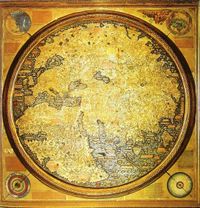Silk Road
2008/9 Schools Wikipedia Selection. Related subjects: General history
The Silk Road, or Silk Route, is a series of trade and cultural transmission routes that were central to cultural interaction through regions of the Asian continent connecting East and West by linking traders, merchants, pilgrims, monks, soldiers, nomads and urban dwellers from China to the Mediterranean Sea during various periods of time. The trade route was initiated around 114 BC by the Han Dynasty (114 BC), although earlier trade across the continents had already existed. Geographically, the Silk Road or Silk Route is an interconnected series of ancient trade routes between Chang'an (today's Xi'an) in China, with Asia Minor and the Mediterranean extending over 8,000 km (5,000 miles) on land and sea. Trade on the Silk Road was a significant factor in the development of the great civilizations of China, Egypt, Mesopotamia, Persia, Indian subcontinent, and Rome, and helped to lay the foundations for the modern world. The first person who used the terms "Seidenstraße" and "Seidenstraßen" or "Silk Road(s)" and "Silk Route(s)", was the German geographer Ferdinand von Richthofen in 1877.
Routes taken
As it extends westwards from the commercial centers of North China, the continental Silk Road divides into north and south routes to avoid the Tibetan Plateau.
The northern route travels northwest through the Chinese province of Gansu, and splits into three further routes, two of them passing north and south of the Taklamakan Desert (through modern day Kyrgyzstan and Xinjiang) to rejoin at Kashgar; and the other going north of the Tien Shan mountains through Turfan, Talgar and Almaty (in what is now southeast Kazakhstan).
All routes join up at Kokand in the Fergana Valley, and the roads continue west across the Karakum Desert towards Merv, joining the northern route briefly.
One of these routes turns northwest along the Amu Darya (river) including Bukhara and Samarkand the centre of Silk Road trade to the Aral Sea, through ancient civilizations under the present site of Astrakhan, and on to the Crimean peninsula. From there it crosses the Black Sea, Marmara Sea and the Balkans to Venice, another crosses the Caspian Sea and across the Caucasus to the Black Sea in Georgia, thence to Constantinople.
The southern route is mainly a single route running through northern India, then the Turkestan– Khorasan region into Mesopotamia and Anatolia; having southward spurs enabling the journey to be completed by sea from various points. It runs south through the Sichuan Basin in China and crosses the high mountains into northeast India, probably via the Ancient tea route. It then travels west along the Brahmaputra and Ganges river plains, possibly joining the Grand Trunk Road west of Varanasi. It runs through northern Pakistan and over the Hindu Kush mountains to rejoin the northern route briefly near Merv.
It then followed a nearly straight line west through mountainous northern Iran and the northern tip of the Syrian Desert to the Levant. From there Mediterranean trading ships plied regular routes to Italy, and land routes went either north through Anatolia or south to North Africa.
Another branching road traveled from Herat through Susa to Charax Spasinu at the head of the Persian Gulf and across to Petra and Alexandria from where ships carried the cargoes to Rome and other Mediterranean ports.
Railway
The last missing link on the Silk Road was completed in 1994, when the international railway between Almaty in Kazakhstan and Urumqi in Xinjiang opened.
Sea
As long as 14 hundred years ago, during the Eastern Han Dynasty in China, the sea route led from the mouth of the Red River near modern Hanoi, all the way through the Malacca Straits to Southeast Asia, Sri Lanka and India, and then on to the Persian Gulf and the Red Sea. From ports on the Red Sea goods, including silks, were transported overland to the Nile and then down to Alexandria from where they were shipped to Rome and other Mediterranean ports. Another branch of these sea routes led down the East African coast (called Azania by the Greeks and Romans and Zesan by the Chinese) at least as far as the port known to the Romans as Rhapta, which was probably located in the delta of the Rufiji River in modern Tanzania.
The Silk Road on the Sea extends from southern China to present day Brunei, Thailand, Malacca, Ceylon, India, Pakistan, the Philippines, and Iran. In Europe it extends from Israel, Lebanon, Egypt, and Italy in the Mediterranean Sea to Portugal and Sweden.
Prehistory
Cross-continental journeys
As the domestication of efficient pack animals and the development of shipping technology both increased the capacity for prehistoric peoples to carry heavier loads over greater distances, cultural exchanges and trade developed rapidly.
In addition, grassland provides fertile grazing, water, and easy passage for caravans. The vast grassland steppes of Asia enables merchants to travel immense distances, from the shores of the Pacific to Africa and deep into Europe, without trespassing on agricultural lands and arousing hostility...
Evidence for ancient transport and trade routes
The ancient peoples of the Sahara imported domesticated animals from Asia between 6000 BC and 4000 BC.
Foreign artifacts dating to the 5th millennium BC in the Badarian culture of Egypt indicate contact with distant Syria.
In predynastic Egypt, by the 4th millennium BC shipping was well established, and the donkey and possibly the dromedary had been domesticated. Domestication of the Bactrian camel and use of the horse for transport then followed.
Also by the beginning of the 4th millennium BC, ancient Egyptians in Maadi were importing pottery as well as construction ideas from Canaan.
By the second half of the 4th millennium BC, the gemstone lapis lazuli was being traded from its only known source in the ancient world — Badakshan, in what is now northeastern Afghanistan — as far as Mesopotamia and Egypt. By the 3rd millennium BC, the lapis lazuli trade was extended to Harappa and Mohenjo-daro in the Indus Valley Civilization of modern day Pakistan and northwestern India. The Indus Valley was also known as Meluhha, the earliest maritime trading partner of the Sumerians and Akkadians in Mesopotamia.
Routes along the Persian Royal Road, constructed in the 5th century BC by Darius I of Persia, may have been in use as early as 3500 BC. Charcoal samples found in the tombs of Nekhen, which were dated to the Naqada I and II periods, have been identified as cedar from Lebanon.
In 1994 excavators discovered an incised ceramic shard with the serekh sign of Narmer, dating to circa 3000 BC. Mineralogical studies reveal the shard to be a fragment of a wine jar exported from the Nile valley to Israel.
The ancient harbour constructed in Lothal, India, around 2400 BC may be the oldest sea-faring harbour known.
Egyptian maritime trade
The Palermo stone mentions King Sneferu of the 4th Dynasty sending ship to import high-quality cedar from Lebanon (see Sneferu). In one scene in the pyramid of Pharaoh Sahure of the Fifth Dynasty, Egyptians are returning with huge cedar trees. Sahure's name is found stamped on a thin piece of gold on a Lebanon chair, and 5th dynasty cartouches were found in Lebanon stone vessels. Other scenes in his temple depict Syrian bears. The Palermo stone also mentions expeditions to Sinai as well as to the diorite quarries northwest of Abu Simbel.
The oldest known expedition to the Land of Punt was organized by Sahure, which apparently yielded a quantity of myrrh,along with malachite and electrum. The 12th-Dynasty Pharaoh Senusret III had a "Suez" canal constructed linking the Nile River with the Red Sea for direct trade with Punt. Around 1950 BC, in the reign of Mentuhotep III, an officer named Hennu made one or more voyages to Punt. In the 15th century BC, Nehsi conducted a very famous expedition for Queen Hatshepsut to obtain myrrh; a report of that voyage survives on a relief in Hatshepsut's funerary temple at Deir el-Bahri. Several of her successors, including Thutmoses III, also organized expeditions to Punt.
Iranian and Scythian Connections
The expansion of Scythian Iranian cultures stretching from the Hungarian plain and the Carpathians to the Chinese Kansu Corridor and linking Iran, and the Middle East with Northern India and the Punjab, undoubtedly played an important role in the development of the Silk Road. Scythians accompanied the Assyrian Esarhaddon on his invasion of Egypt, and their distinctive triangular arrowheads have been found as far south as Aswan. These nomadic peoples were dependent upon neighbouring settled populations for a number of important technologies, and in addition to raiding vulnerable settlements for these commodities, also encouraged long distance merchants as a source of income through the enforced payment of tariffs. Soghdian Scythian merchants were in later periods to play a vital role in the development of the Silk Road.
Chinese and Central Asian contacts
From the 2nd millennium BC nephrite jade was being traded from mines in the region of Yarkand and Khotan to China. Significantly, these mines were not very far from the lapis lazuli and spinel ("Balas Ruby") mines in Badakhshan and, although separated by the formidable Pamir Mountains, routes across them were, apparently, in use from very early times.
The Tarim mummies, Chinese mummies of non-Chinese, apparently western, individuals, have been found in the Tarim Basin, such as in the area of Loulan located along the Silk Road 200 km east of Yingpan, dating to as early as 1600 BC and suggesting very ancient contacts between East and West. It has been suggested that these mummified remains may have been of people related to the Tocharians whose Indo-European language remained in use in the Tarim Basin (modern day Xinjiang) of China until the 8th century.
Some remnants of what was probably Chinese silk have been found in Ancient Egypt from 1070 BC. Though the originating source seems sufficiently reliable, silk unfortunately degrades very rapidly and we cannot double-check for accuracy whether it was actually cultivated silk (which would almost certainly have come from China) that was discovered or a type of " wild silk," which might have come from the Mediterranean region or the Middle East.
Following contacts of metropolitan China with nomadic western border territories in the 8th century BC, gold was introduced from Central Asia, and Chinese jade carvers began to make imitation designs of the steppes, adopting the Scythian-style animal art of the steppes (descriptions of animals locked in combat). This style is particularly reflected in the rectangular belt plaques made of gold and bronze with alternate versions in jade and steatite.
Persian Royal Road
By the time of Herodotus (c. 475 BC) the Persian Royal Road ran some 2,857 km from the city of Susa on the lower Tigris to the port of Smyrna (modern İzmir in Turkey) on the Aegean Sea. It was maintained and protected by the Achaemenid Empire (c.500-330 BC) and had postal stations and relays at regular intervals. By having fresh horses and riders ready at each relay, royal couriers could carry messages the entire distance in 9 days, though normal travellers took about three months. This Royal Road linked into many other routes. Some of these, such as the routes to India and Central Asia, were also protected by the Achaemenids, encouraging regular contact between India, Mesopotamia and the Mediterranean. There are accounts in Esther of dispatches being sent from Susa to provinces as far out as India and Cush during the reign of Xerxes (485-465 BC).
History
Hellenistic Era
The first major step in opening the Silk Road between the East and the West came with the expansion of Alexander the Great's empire into Central Asia. In August 329 BC, at the mouth of the Fergana Valley in Tajikistan he founded the city of Alexandria Eschate or "Alexandria The Furthest". This later became a major staging point on the northern Silk Route.
In 323 BC, Alexander the Great’s successors, the Ptolemies, took control of Egypt. They actively promoted trade with Mesopotamia, India, and East Africa through their Red Sea ports and over land. This was assisted by a number of intermediaries, especially the Nabataeans and other Arabs.
The Greeks remained in Central Asia for the next three centuries, first through the administration of the Seleucid Empire, and then with the establishment of the Greco-Bactrian Kingdom in Bactria. They continued to expand eastward, especially during the reign of Euthydemus (230–200 BC) who extended his control beyond Alexandria Eschate to Sogdiana. There are indications that he may have led expeditions as far as Kashgar in Chinese Turkestan, leading to the first known contacts between China and the West around 200 BC. The Greek historian Strabo writes “they extended their empire even as far as the Seres (China) and the Phryni.”
Chinese exploration of Central Asia
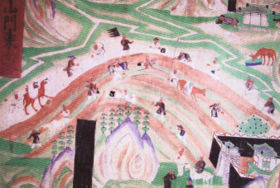
The next step came around 130 BC, with the embassies of the Han Dynasty to Central Asia, following the reports of the ambassador Zhang Qian (who was originally sent to obtain an alliance with the Yuezhi against the Xiongnu). The Chinese Emperor Wu Di became interested in developing commercial relationship with the sophisticated urban civilizations of Ferghana, Bactria and Parthia: “The Son of Heaven on hearing all this reasoned thus: Ferghana (Dayuan) and the possessions of Bactria ( Ta-Hsia) and Parthia ( Anxi) are large countries, full of rare things, with a population living in fixed abodes and given to occupations somewhat identical with those of the Chinese people, but with weak armies, and placing great value on the rich produce of China” (Hou Hanshu, Later Han History).
The Chinese were also strongly attracted by the tall and powerful horses in the possession of the Dayuan (named “Heavenly horses”), which were of capital importance in fighting the nomadic Xiongnu. The Chinese subsequently sent numerous embassies, around ten every year, to these countries and as far as Seleucid Syria. “Thus more embassies were dispatched to Anxi [Parthia], Yancai [who later joined the Alans ], Lijian [Syria under the Seleucids], Tiaozhi [Chaldea], and Tianzhu [northwestern India]… As a rule, rather more than ten such missions went forward in the course of a year, and at the least five or six.” (Hou Hanshu, Later Han History). The Chinese campaigned in Central Asia on several occasion, and direct encounters between Han troops and Roman legionaries (probably captured or recruited as mercenaries by the Xiong Nu) are recorded, particularly in the 36 BC battle of Sogdiana (Joseph Needham, Sidney Shapiro). It has been suggested that the Chinese crossbow was transmitted to the Roman world on such occasions, although the Greek gastraphetes provides an alternative origin. R. Ernest Dupuy and Trevor N. Dupuy suggest that in 36 B.C., a "Han expedition into central Asia, west of Jaxartes River, apparently encountered and defeated a contingent of Roman legionaries. The Romans may have been part of Antony's army invading Parthia. Sogdiana (modern Bukhara), east of the Oxus River, on the Polytimetus River, was apparently the most easterly penetration ever made by Roman forces in Asia. The margin of Chinese victory appears to have been their crossbows, whose bolts and darts seem easily to have penetrated Roman shields and armor."
The Roman historian Florus also describes the visit of numerous envoys, included Seres (Chinese), to the first Roman Emperor Augustus, who reigned between 27 BC and 14:
- "Even the rest of the nations of the world which were not subject to the imperial sway were sensible of its grandeur, and looked with reverence to the Roman people, the great conqueror of nations. Thus even Scythians and Sarmatians sent envoys to seek the friendship of Rome. Nay, the Seres came likewise, and the Indians who dwelt beneath the vertical sun, bringing presents of precious stones and pearls and elephants, but thinking all of less moment than the vastness of the journey which they had undertaken, and which they said had occupied four years. In truth it needed but to look at their complexion to see that they were people of another world than ours." ("Cathay and the way thither", Henry Yule).
The "Silk Road" essentially came into being from the 1st century BC, following these efforts by China to consolidate a road to the Western world and India, both through direct settlements in the area of the Tarim Basin and diplomatic relations with the countries of the Dayuan, Parthians and Bactrians further west. The Han Dynasty Chinese army regularly police the trade route against nomadic bandit forces. Han general Ban Chao led an army of 70,000 mounted infantry and light cavalry troops in the 1st century AD to secure the trade routes, reaching far west across central Asia to the doorstep of Europe, and setting up base on the shores of the Caspian Sea.
A maritime "Silk Route" opened up between Chinese-controlled Jiaozhi (centred in modern Vietnam [see map above], near Hanoi) probably by the 1st century. It extended, via ports on the coasts of India and Sri Lanka, all the way to Roman-controlled ports in Egypt and the Nabataean territories on the northeastern coast of the Red Sea.
The Roman Empire
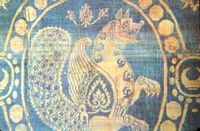
Soon after the Roman conquest of Egypt in 30 BC, regular communications and trade between India, Southeast Asia, Sri Lanka, China, the Middle East, Africa and Europe blossomed on an unprecedented scale. The party of Maës Titianus became the travellers who penetrated farthest east along the Silk Road from the Mediterranean world, probably with the aim of regularizing contacts and reducing the role of middlemen, during one of the lulls in Rome's intermittent wars with Parthia, which repeatedly obstructed movement along the Silk Road. Land and maritime routes were closely linked, and novel products, technologies and ideas began to spread across the continents of Europe, Asia and Africa. Intercontinental trade and communication became regular, organised, and protected by the 'Great Powers.' Intense trade with the Roman Empire followed soon, confirmed by the Roman craze for Chinese silk (supplied through the Parthians), even though the Romans thought silk was obtained from trees. This belief was affirmed by Seneca the Younger in his Phaedra and by Virgil in his Georgics. Notably, Pliny the Elder knew better. Speaking of the bombyx or silk moth, he wrote in his Natural Histories "They weave webs, like spiders, that become a luxurious clothing material for women, called silk."
The Senate issued, in vain, several edicts to prohibit the wearing of silk, on economic and moral grounds: the importation of Chinese silk caused a huge outflow of gold, and silk clothes were considered to be decadent and immoral:
- “I can see clothes of silk, if materials that do not hide the body, nor even one's decency, can be called clothes… Wretched flocks of maids labour so that the adulteress may be visible through her thin dress, so that her husband has no more acquaintance than any outsider or foreigner with his wife's body” ( Seneca the Younger (c.3 BC–65, Declamations Vol. I).
The Hou Hanshu records that the first Roman envoy arrived in China by this maritime route in 166, initiating a series of Roman embassies to China.
Medieval Era
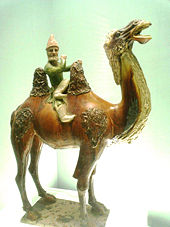
The main traders during Antiquity were the Indian and Bactrian Traders, then from the fifth to the eighth c. the Sogdian traders, then the Persian traders.
The unification of Central Asia and Northern India within Kushan empire in the first to third centuries reinforced the role of the powerful merchants from Bactria and Taxila . They fostered multi-cultural interaction as indicated by their 2nd century treasure hoards filled with products from the Greco-Roman world, China and India, such as in the archeological site of Begram.
The heyday of the Silk Road corresponds to that of the Byzantine Empire in its west end, Sassanid Empire Period to Il Khanate Period in the Nile- Oxus section and Three Kingdoms to Yuan Dynasty in the Sinitic zone in its east end. Trade between East and West also developed on the sea, between Alexandria in Egypt and Guangzhou in China, fostering the expansion of Roman trading posts in India. Historians also talk of a "Porcelain Route" or "Silk Route" across the Indian Ocean. The Silk Road represents an early phenomenon of political and cultural integration due to inter-regional trade. In its heyday, the Silk Road sustained an international culture that strung together groups as diverse as the Magyars, Armenians, and Chinese.
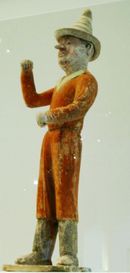
Under its strong integrating dynamics on the one hand and the impacts of change it transmitted on the other, tribal societies previously living in isolation along the Silk Road or pastoralists who were of barbarian cultural development were drawn to the riches and opportunities of the civilizations connected by the Silk Road, taking on the trades of marauders or mercenaries. Many barbarian tribes became skilled warriors able to conquer rich cities and fertile lands, and forge strong military empires.
The Sogdians dominated the East-West trade after the 4th century AD up to the 8th century AD, with Suyab and Talas ranking among their main centeres in the north. They were the main caravan merchants of Central Asia. Their commercial interests were protected by the resurgent military power of the Göktürks, whose empire has been described as "the joint enterprise of the Ashina clan and the Soghdians" . Their trades with some interruptions continued in 9th century. It is occurred in 10th century within the framework of the Uighur Empire, which until 840 extended all over northern Central Asia and obtained from China enormous deliveries of silk in exchange for horses. At this time caravans of Sogdians traveling to Upper Mongolia are mentioned in Chinese sources. They played an equally important religious and cultural role. Part of the data about eastern Asia provided by Muslim geographers of the 10th century actually goes back to Sogdian data of the period 750-840 and thus shows the survival of links between east and west. However, after the end of the Uighur Empire, Sogdian trade went through a crisis. What mainly issued from Muslim Central Asia was the trade of the Samanids, which resumed the northwestern road leading to the Khazars and the Urals and the northeastern one toward the nearby Turkic tribes .
The Silk Road gave rise to the clusters of military states of nomadic origins in North China, invited the Nestorian, Manichaean, Buddhist, and later Islamic religions into Central Asia and China, created the influential Khazar Federation and at the end of its glory, brought about the largest continental empire ever: the Mongol Empire, with its political centers strung along the Silk Road (Beijing in North China, Karakorum in central Mongolia, Sarmakhand in Transoxiana, Tabriz in Northern Iran, Astrakhan in lower Volga, Solkhat in Crimea, Kazan in Central Russia, Erzurum in eastern Anatolia), realizing the political unification of zones previously loosely and intermittently connected by material and cultural goods.
The Roman Empire, and its demand for sophisticated Asian products, crumbled in the West around the 5th century. In Central Asia, Islam expanded from the 7th century onward, bringing a stop to Chinese westward expansion at the Battle of Talas in 751. Further expansion of the Islamic Turks in Central Asia from the 10th century finished disrupting trade in that part of the world, and Buddhism almost disappeared.
Mongol era
The Mongol expansion throughout the Asian continent from around 1215 to 1360 helped bring political stability and re-establish the Silk Road (via Karakorum). The Chinese Mongol diplomat Rabban Bar Sauma visited the courts of Europe in 1287-1288 and provided a detailed written report back to the Mongols. Around the same time, the Venetian explorer Marco Polo became one of the first Europeans to travel the Silk Road to China, and his tales, documented in Il Milione, opened Western eyes to some of the customs of the Far East. He was not the first to bring back stories, but he was one of the widest-read. He had been preceded by numerous Christian missionaries to the East, such as William of Rubruck, Benedykt Polak, Giovanni da Pian del Carpine, and Andrew of Longjumeau. Later envoys included Odoric of Pordenone, Giovanni de' Marignolli, John of Montecorvino, Niccolò Da Conti, or Ibn Battuta, a Moroccan muslim traveller, who passed through the present day Middle-east and took the Silk Road from Tabriz, between 1325-1354.
The 13th century also saw attempts at a Franco-Mongol alliance, with exchange of ambassadors and (failed) attempts at military collaboration in the Holy Land during the later Crusades, though eventually the Mongols in the Ilkhanate, after they had destroyed the Abbasid and Ayyubid dynasties, eventually themselves converted to Islam, and signed the 1323 Treaty of Aleppo with the surviving Muslim power, the Egyptian Mamluks.
Disintegration
However, with the disintegration of the Mongol Empire also came discontinuation of the Silk Road's political, cultural and economic unity. Turkmeni marching lords seized the western part of the Silk Road — the decaying Byzantine Empire. After the Mongol Empire, the great political powers along the Silk Road became economically and culturally separated. Accompanying the crystallization of regional states was the decline of nomad power, partly due to the devastation of the Black Death and partly due to the encroachment of sedentary civilizations equipped with gunpowder.
The effect of gunpowder and early modernity on Europe was the integration of territorial states and increasing mercantilism; whereas on the Silk Road, gunpowder and early modernity had the opposite impact: the level of integration of the Mongol Empire could not be maintained, and trade declined (though partly due to an increase in European maritime exchanges).
The Silk Road stopped serving as a shipping route for silk around 1400.
For more information on Disintegration see Silk Road
The great explorers: Europe reaching for Asia
The disappearance of the Silk Road following the end of the Mongols was one of the main factors that stimulated the Europeans to reach the prosperous Chinese empire through another route, especially by the sea. Tremendous profits were to be obtained for anyone who could achieve a direct trade connection with Asia.

When he went West in 1492, Christopher Columbus reportedly wished to create yet another Silk Route to China. It was allegedly one of the great disappointments of western nations to have found a continent "in-between" before recognizing the potential of a "New World."
In 1594 Willem Barents left Amsterdam with two ships to search for the Northeast passage north of Siberia, on to eastern Asia. He reached the west coast of Novaya Zemlya, and followed it northward, being finally forced to turn back when confronted with its northern extremity. By the end of the 17th century, the Russians reestablished a land trade route between Europe and China under the name of the Great Siberian Road.
The wish to trade directly with China was also the main drive behind the expansion of the Portuguese beyond Africa after 1480, followed by the powers of the Netherlands and Great Britain from the 17th century. As late as the 18th century, China was usually still considered the most prosperous and sophisticated of any civilization on earth, however its per capita income was low relative to western Europe at that time. Leibniz, echoing the prevailing perception in Europe until the Industrial Revolution, wrote in the 17th century: “Everything exquisite and admirable comes from the East Indies… Learned people have remarked that in the whole world there is no commerce comparable to that of China” (Leibniz).
In the 18th century, Adam Smith, declared that China had been one of the most prosperous nations in the world, but that it had remained stagnant for a long time and its wages always were low and the lower classes were particularly poor
- “China has been long one of the richest, that is, one of the most fertile, best cultivated, most industrious, and most populous countries in the world. It seems, however, to have been long stationary. Marco Polo, who visited it more than five hundred years ago, describes its cultivation, industry, and populousness, almost in the same terms as travellers in the present time describe them. It had perhaps, even long before his time, acquired that full complement of riches which the nature of its laws and institutions permits it to acquire.” (Adam Smith, The Wealth of Nations, 1776).
In effect, the spirit of the Silk Road and the will to foster exchange between the East and West, and the lure of the huge profits attached to it, has affected much of the history of the world during these last three millennia.
Cultural Exchanges on the Silk Road
Notably, the Buddhist faith and the Greco-Buddhist culture started to travel eastward along the Silk Road, penetrating in China from around the 1st century BC.
The Silk Road transmission of Buddhism to China started in the 1st century CE with a semi-legendary account of an embassy sent to the West by the Chinese Emperor Ming (58 – 75 CE). Extensive contacts however started in the 2nd century CE, probably as a consequence of the expansion of the Kushan empire into the Chinese territory of the Tarim Basin, with the missionnary efforts of a great number of Central Asian Buddhist monks to Chinese lands. The first missionaries and translators of Buddhists scriptures into Chinese were either Parthian, Kushan, Sogdian or Kuchean.
From the 4th century onward, Chinese pilgrims also started to travel to India, the origin of Buddhism, by themselves in order to get improved access to the original scriptures, with Fa-hsien's pilgrimage to India (395-414), and later Xuan Zang (629-644). The Silk Road transmission of Buddhism essentially ended around the 7th century with the rise of Islam in Central Asia.
Artistic transmission
Many artistic influences transited along the Silk Road, especially through the Central Asia, where Hellenistic, Iranian, Indian and Chinese influence were able to intermix. In particular Greco-Buddhist art represent one of the most vivid examples of this interaction.
Buddhist deities
The image of the Buddha, originating during the 1st century in northern India (areas of Gandhara and Mathura) was transmitted progressively through Central Asia and China until it reached Korea in the 4th century and Japan in the 6th century. However the transmission of many iconographical details are clear, such as the Hercules inspiration behind the Nio guardian deities in front of Japanese Buddhist temples, and also representations of the Buddha reminiscent of Greek art such as the Buddha in Kamakura. Another Buddhist deity, Shukongoshin, is also an interesting case of transmission of the image of the famous Greek god Herakles to the Far-East along the Silk Road. Herakles was used in Greco-Buddhist art to represent Vajrapani, the protector of the Buddha, and his representation was then used in China, Korea, and Japan to depict the protector gods of Buddhist temples.
Wind god
The name of the west wind in Latin is Zephyr. Various other artistic influences from the Silk Road can be found in Asia, one of the most striking being that of the Greek Wind God Boreas, transiting through Central Asia and China to become the Japanese Shinto wind god Fujin.
Floral scroll pattern
Finally the Greek artistic motif of the floral scroll was transmitted from the Hellenistic world to the area of the Tarim Basin around the 2nd century, as seen in Serindian art and wooden architectural remains. It then was adopted by China between the 4th and 6th century and displayed on tiles and ceramics; then it transmitted to Japan in the form of roof tile decorations of Japanese Buddhist temples circa 7th century, particularly in Nara temple building tiles, some of them exactly depicting vines and grapes .
Technological transfer to the West
The period of the High Middle Ages in Europe saw major technological advances, including the adoption through the Silk Road of printing, gunpowder, the astrolabe, and the compass.
Korean maps such as the Kangnido and Islamic mapmaking seem to have influenced the emergence of the first practical world maps, such as those of De Virga or Fra Mauro. Ramusio, a contemporary, states that Fra Mauro's map is "an improved copy of the one brought from Cathay by Marco Polo".
Large Chinese junks were also observed by these travelers and may have provided impetus to develop larger ships in Europe.
- “The ships, called junks, that navigate these seas carry four masts or more, some of which can be raised or lowered, and have 40 to 60 cabins for the merchants and only one tiller.” (Text from the Fra Mauro map, 09-P25)
- “A ship carries a complement of a thousand men, six hundred of whom are sailors and four hundred men-at-arms, including archers, men with shields and crossbows, who throw naphtha… These vessels are built in the towns of Zaytun (a.k.a Zaitun, today's Quanzhou; 刺桐) and Sin-Kalan. The vessel has four decks and contains rooms, cabins, and saloons for merchants; a cabin has chambers and a lavatory, and can be locked by its occupants.” (Ibn Battuta).
